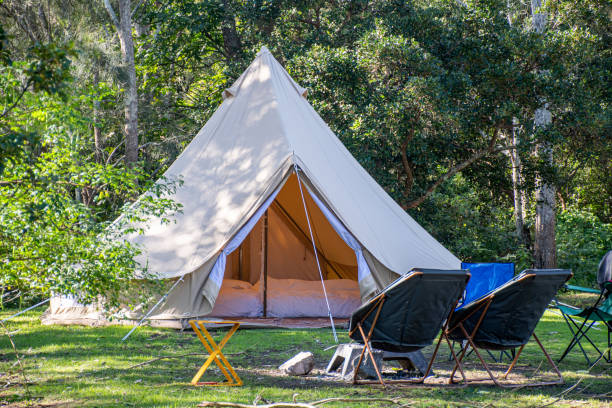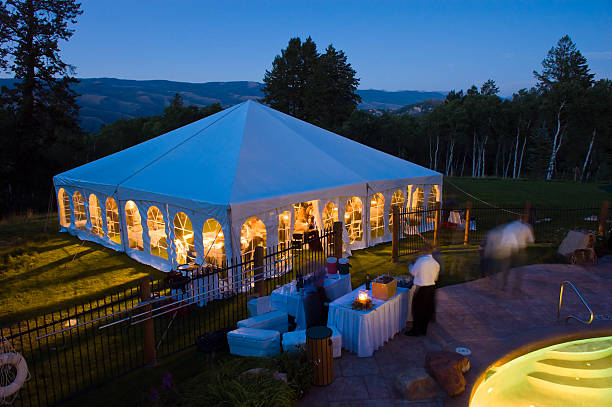When planning an outdoor event or gathering, two popular shelter options are teepees and party tents. But what exactly are the differences between these structures and which is better for your needs? This comprehensive guide examines the distinctions between teepees and party tents to help you decide.
What is a Teepee?
A teepee is a cone-shaped tent structure originally used by certain Native American tribes. Modern teepees use updated materials but keep the same distinctive shape.
Key Features:
- The tall, narrow cone design comes with a smoke-flap opening at the top
- Supported by long wooden poles that lean together and are covered with canvas or plastic
- Range of sizes from small (6 ft) to quite large (20+ ft diameter)
- The entrance is a low doorway with fabric flaps or zipper
- The fire pit is located in the center for heating and cooking
- Associated with Native American culture and symbolism
Teepees create a close, cozy shelter well-suited for camping, temporary housing, or cultural ceremonies. Their enclosed space traps rising heat while the top smoke opening allows ventilation.
What is a Party Tent?
Party tents are portable open-air structures commonly used for modern outdoor entertaining and events. They provide spacious, adaptable coverage.
Key Features:
- Typically square or rectangular shaped with open sides
- Supported by a pole frame with a fabric roof and adjustable legs
- Offer great versatility in size from 10×10 ft up to 40×100 ft
- The entrance is open and accessible from all sides
- The interior space is open for customization
- Associated with backyard parties, festivals, fairs, and events
Party tents allow free flow of people in and out while sheltering the interior from sun and rain. Their open layout can be flexibly furnished and customized.
Differences Between Teepees and Party Tents
While both are outdoor shelters, teepees and party tents differ in some important ways:
| Teepees | Party Tents |
|---|---|
| Conical, circular floorplan | Square, rectangular, or custom polygonal floorplan |
| Enclosed design with one entrance | Open on all sides with free-flowing access |
| Smaller capacity (usually just a few people) | Much larger capacity (dozens to hundreds of people) |
| Generally lower height profile | Tall overhead space up to 20+ feet high |
| Supported by poles arranged in tripod form | Frame of poles on each corner and sides |
| Canvas or plastic fabric | Polyester or vinyl fabric covers |
| Heating by interior fire pit | No built-in heating source |
| Symbolic cultural history | More generic, utilitarian design |
| Used for camping, ceremonies | Used for fairs, parties, events |
| Limited customization due to size | Highly customizable with furniture, lighting, decor |
| Smoky ventilation out top | Open-air cross breeze through sides |
While teepees emphasize history and close-knit utility, party tents focus on spacious, adaptable protection for larger groups. This makes them suited for different purposes.
Advantages of Teepees
Teepees have some unique benefits that make them ideal for certain situations:
Compact, Stable Shape – The teepee’s aerodynamic silhouette performs well in wind and shed precipitation. The conical shape also efficiently resists lateral forces.
Warmth and Ventilation – The central fire pit, smoke flap, and convection airflow keep the interior well-heated and ventilated.
Portability – Teepees can be transported in the form of compact poles and a canvas tarp then quickly assembled on location.
Cultural Significance – Teepees hold special meaning and history, making them ideal for educational or ceremonial purposes.
Community Setting – The cozy circular interior promotes close interaction and communication between occupants.
Minimal Setup – Basic teepees require just tent poles, canvas, and a fire pit for quick deployment.
For small-group camping or cultural experiences, a teepee offers advantages over an open-party tent design.

Advantages of Party Tents
Party tent shelters provide their own set of useful benefits:
Spacious Coverage – Party tents start at 10×10 ft and up to 40×100 ft to handle sizable crowds and events.
Open Access – The lack of walls allows the free flow of people in and out of the perimeter from any direction.
Customizable Layout – The empty interior can be flexibly furnished with seating, tables, stages, decorations, lighting, and more.
Overhead Protection – The waterproof roof provides reliable shelter from sun, rain, and weather.
High Capacity – Party tents can accommodate anywhere from 50 to 500+ people comfortably.
Multi-Purpose – The non-specific design suits many different types of occasions and setups.
Climate Control – Party tents allow techniques like draping, fans, and heating to regulate interior temperature and airflow.
For major events and large group assemblies, party tents are the better solution.

Ideal Uses of Teepees
Here are some of the most suitable applications for teepees based on their advantages:
- Camping trips, especially with groups like Scouts
- Temporary disaster shelters and housing structures
- Cultural experiences, education, and historic re-enactments involving Native American lifestyles
- Backyard play structures for children
- Solo retreats into nature for reflection and solitude
- Small backyard gatherings around a fire pit
- Music festivals and events aiming for a natural, eco-friendly aesthetic
- Outdoor weddings with a bohemian, woodsy style
Ideal Uses of Party Tents
Party tents are optimized for these particular uses:
- Large backyard parties, weddings, graduations, and reunions
- Corporate events, concerts, conferences, and conventions
- Food and craft markets, fairs, and pop-up vendor events
- Sporting events, tournaments, races, and competitions
- Outdoor food service for restaurants, caterers, and concession stands
- Agricultural exhibitions, auctions, and 4-H events
- Trade shows, expos, and outdoor retail shops
- Temporary first aid stations, field hospitals, and military camps
- Disaster relief sites, refugee camps, and emergency shelters
- Park shelters, public gathering spaces, and community functions
The roomy interior and modular walls make party tents the preferred choice for sizable gatherings and occasions.
Cost Differences
Another consideration is the cost difference between teepees and party tents:
Teepees – Smaller teepees start around $100 while large 20 ft versions can run $500 or more. High-end teepees with decorative paints and leather accents are priced upwards of $1,500.
Party Tents – Basic 10×10 ft party tents can cost as little as $100 for budget canopies but sturdy premium models run $300 to $500. Sizes over 20×40 ft often exceed $1,000 or more.
So teepees tend to be more expensive per square foot but accommodate far fewer people. Party tents offer economies of scale for very large events.
Set Up and Portability Comparison
Ease of transport and assembly is another key distinction:
Teepees
- Compact disassembled parts
- Lightweight but bulky long poles
- Typically 10-30 minutes to set up
- Requires securing and orienting poles correctly
Party Tents
- Many collapsible models with wheeled carrycases
- Heavier frames with more connection points
- Pop-up tents take just 1-2 minutes
- More idiot-proof assembly but very large tents require machinery
Party tents in the 10-20 ft range are easier for one person to transport and assemble. Giant tents may require equipment to erect.
Appearance and Aesthetics
Visually, the two shelters evoke very different aesthetics:
Teepees
- Tall, eye-catching cone silhouette
- Natural canvas or plastic cover
- Warm, inviting glow of interior fire
- Rustic, earthy, bohemian personality
Party Tents
- Square or rectangular canvas canopy
- Crisp, geometric lines and angles
- Open airy interior with freedom of layout
- Clean, utility appearance for diverse functions
Which is more attractive comes down to personal taste and context. For a festival, teepees likely complement the environment better. But for a catered cocktail reception, a party tent projects a more refined image.
Weather Resistance Comparison
Both structures must be able to withstand outdoor conditions:
Teepees
- Conical shape handles wind well
- Smoke flaps ventilate heat and moisture
- Vulnerable to side collapse if poorly staked
- Cold air drafts more easily into the low opening
Party Tents
- The square shape catches more wind resistance
- Sidewalls help block wind and rain
- More anchoring points prevent blow-overs
- Room for portable heaters to warm the interior
When situated appropriately, teepees and tents are reasonably capable of sheltering occupants from the elements. But tents provide more control over the interior climate.
Safety and Structural Integrity
It’s also important to evaluate structural soundness:
Teepees
- Vulnerable to fire spreading up canvas sides
- Minimal framing can risk collapse if not staked properly
- Difficult to exit quickly through a low tight opening
- No overhead support if the center pole dislodged
Party Tents
- Flame retardant fabric minimizes fire risk
- Robust jointed frame prevents sudden collapse
- Open sides allow rapid evacuation
- The roof remains stable even if one pole fails
Party tents follow more rigorous engineering standards for keeping occupants secure in storms, fires, and emergencies.
Lighting Comparison
Interior lighting options also differ:
Teepees
- Central fire provides ambient light
- Lamp oils, lanterns, or string lights used
- Shadowy periphery lighting from the central fire
Party Tents
- Fully illuminated with portable string lights
- Individual lighting fixtures can highlight zones
- Brighter, more even lighting throughout the interior
Tents accommodate more general or task lighting for activities. Teepees rely more on mood lighting from a fire.
Furnishing and Layout Flexibility
Both structures have different furnishing requirements:
Teepees
- Built-in central fire pit
- Mostly floor seating around the pit
- Difficult to bring large furniture through the entrance
- Very limited floor space
Party Tents
- Empty blank canvas for furnishings
- Tables, chairs, stages, bars, lighting arranged as needed
- High ceilings allow large fixtures and decor overhead
- Spacious floorplan facilitates any required layout
The fixed, tight footprint of a teepee restricts decor options. Party tents enable endless customizable configurations.
Choosing Between Teepees and Party Tents
In summary, here are some best practices on when to choose each shelter:
When to Choose Teepees
- For intimate gatherings under 12 people
- To replicate Native American structures and culture
- For small, self-contained camping or disaster shelters
- If seeking cozy, warm, natural aesthetics
- When symbolic or ceremonial meaning is important
When to Choose Party Tents
- For any gathering exceeding 15+ people
- If hosting a reception, banquet, or formal event
- When flexibility in layout, lighting, and decor is needed
- For commercial venues, festivals, and public events
- To accommodate stages, vendors, cooking areas, bars
- For any large-scale community functions
Frequently Asked Questions
Which is more durable, teepees or party tents?
Party tents tend to be more durable with their sturdy interlocking frames and tightly engineered corner joints. Teepees rely on simple poles and stakes which are more vulnerable to wind forces and deterioration over time.
Do teepees or party tents offer better weather protection?
Party tents provide more controlled shelter since sidewalls, doors, and heating can regulate the interior environment. Teepees are more directly exposed to wind, rain, and cold through the conical sides and low doorway.
Which structure is easier to clean and maintain?
Party tents win again for easier maintenance with their open layout, removable fabric covers, and wipeable vinyl materials. It’s nearly impossible to thoroughly clean the fixed, heavy canvas inside a teepee.
Can teepees accommodate tables, chairs, lighting, etc like a party tent?
While possible, it’s extremely impractical and difficult to furnish a teepee’s tight space beyond simple floor seating. Party tents are specifically designed for flexible placement of furniture, fixtures, and decor.
Which is faster to set up, a teepee or a party tent?
For larger sizes over 10×10 ft, pop-up party tents are fastest taking just 1-2 minutes to deploy. Even large teepees require at least 20-30 minutes for proper layout and securing of numerous poles. Small teepees under 8 ft may be faster.
How many guests can fit inside an average teepee vs party tent?
A 10 ft diameter teepee safely fits 8-10 seated people maximum. A 10×10 ft party tent can handle 25-50 guests standing, 10-20 seated. Tents provide far greater capacity, especially as size increases.
Is one structure safer than the other in high winds?
Party tents are engineered to withstand wind gusts usually around 50 mph or more. Teepees are more vulnerable to wind forces that can bend and topple the simple poles. Proper anchoring is critical for teepees in windy regions.
Which is better for cold weather insulation and protection?
Party tents allow easier climate control through portable heaters while retaining warm air inside. Teepees have more exposed surface area causing heat loss. Tents provide a warmer, more insulated interior space.
My Closing Words
Teepees and party tents fulfill different shelter roles. While party tents are better suited for most major events and gatherings, the cozy teepee remains unrivaled for intimate cultural charm. By weighing your particular needs for space, setup, weather resistance, and decor flexibility, you can decide which structure style makes the most sense.
Just be sure to size appropriately and reinforce the structure against winds as needed to keep occupants comfortable and secure. With smart planning, both teepees and party tents can create lasting memories of meaningful connection and celebration.









